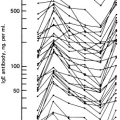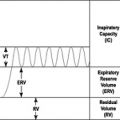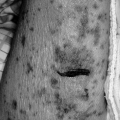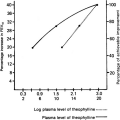Part C
Immunologic Reactions to High-Molecular-Weight Therapeutic Agents
Immunologic Reactions to High-Molecular-Weight Therapeutic Agents
Leslie C. Grammer
Most therapeutic agents are small haptens, less than 1 kDa, which require conjugation to a large molecule, usually a protein, in order to be recognized by the human immunologic system. However, there are increasing numbers of therapeutic agents that are proteins, including humanized monoclonal antibodies such as infliximab and recombinant human proteins such as erythropoietin. Therapeutic agents that are proteins, either of human or nonhuman origin, greater than 3 kDa to 5 kDa, can be recognized by the human immunologic system and can cause sensitization and hypersensitivity reactions. Because these proteins are complete antigens, they can be used as skin testing reagents or as antigens in in vitro assays. Nonhuman protein hormones like porcine insulin and adrenocorticotropic hormone (ACTH) are well-recognized causes of hypersensitivity reactions (1). Nonhuman protein enzymes like chymopapain and streptokinase have been reported to cause anaphylaxis and other milder hypersensitivity reactions (2). Antithymocyte globulin (ATG), derived from rabbit or equine sources, has been reported to cause immediate type I hypersensitivity as well as type III immune complex–mediated hypersensitivity (3).
Human recombinant proteins are less likely than nonhuman proteins to result in hypersensitivity reactions, but they do occur. Factors influencing the immunogenicity of proteins include frequency and duration of treatment, route of administration, and genetic background of the patient (4). A likely explanation for this somewhat unexpected occurrence is that the hypersensitivity reactions are caused by B-cell recognition of alteration in tertiary or quaternary structure. The primary amino acid sequence, recognized by T cells, is an exact copy of the endogenously produced human protein and, therefore, cannot initiate immunologic processes such as hypersensitivity (5). Insulin was the first recombinant human protein to which hypersensitivity reactions were reported (1). Initially, most of the patients who were identified as allergic to human recombinant insulin had actually been sensitized to porcine or bovine insulin. Subsequently, however, there were reports of human recombinant proteins, such as granulocyte-macrophage colony-stimulating factor (GM-CSF), and soluble type I interleukin-1 (IL-1) receptor, causing hypersensitivity reactions with no prior sensitization to nonhuman analogue proteins (6).
Insulin
Background
The exact incidence of insulin allergy is unknown; however, it appears to be on the decline (1). The increasing use of human recombinant DNA (rDNA) insulin may in part be responsible. However, it should be noted that human rDNA insulin has been associated with severe allergic reactions. Patients with systemic allergy to animal source insulins have demonstrated cutaneous reactivity to human rDNA insulin (7). In most patients, the anti-insulin antibody appears to be directed against a determinant present in all
commercially available insulins (8). There has even been a report of systemic allergy to endogenous insulin during therapy with recombinant insulin (9).
commercially available insulins (8). There has even been a report of systemic allergy to endogenous insulin during therapy with recombinant insulin (9).
While about 40% of patients receiving porcine insulin developed clinically insignificant skin test reactivity to insulin, the prevalence of cutaneous reactivity in patients receiving human rDNA insulin is unknown. Immunologic insulin resistance that is due to anti-insulin IgG antibodies may follow or occur simultaneously with IgE-mediated insulin allergy (7). The most common, clinically important, immunologic reactions to insulin are local and systemic allergic reactions and insulin resistance.
Local allergic reactions are common, usually appear within the first 1 to 4 weeks of treatment, and consist of mild erythema, induration, burning, and pruritus at the injection site. Immediate, delayed, and biphasic IgE-mediated reactions have been described. Although most local allergic reactions disappear in 3 to 4 weeks with continued insulin administration, they may persist and may precede a systemic reaction. Discontinuing insulin because of local reactions may increase the risk for a systemic allergic reaction when insulin therapy is resumed. Treatment of local reactions, which is occasionally indicated, involves the administration of antihistamines as needed; in some cases, it may be useful to switch to a different preparation.
Systemic allergic reactions to insulin are IgE-mediated and are characterized by urticaria, angioedema, bronchospasm, and hypotension; such reactions are rare (11). Most commonly, these patients have a history of interruption in insulin treatment. Systemic reactions occur most frequently within 2 weeks of resumption of insulin therapy and are often preceded by the development of progressively larger local reactions. It is most common to have a large urticarial lesion at the site of insulin injection.
Immunologic insulin resistance is even more rare than insulin allergy and is related to the development of anti-insulin IgG antibodies of sufficient titer and affinity to inactivate large amounts of exogenously administered insulin, generally in excess of 200 units daily. When nonimmune causes of insulin resistance such as obesity, infection, and endocrinopathies have been excluded, treatment involves the use of corticosteroids, for example, 60 mg to 100 mg prednisone daily. This is effective in the majority of patients, and improvement is expected during the first 2 weeks of treatment. The dose of prednisone is decreased gradually once a response has occurred, but many patients may require small doses, such as 15 mg on alternate days, for up to 6 to 12 months (8).
Management of Patients with Systemic Insulin Allergy
After a systemic allergic reaction to insulin, and presuming insulin treatment is necessary, insulin should not be discontinued if the last dose of insulin has been given within 24 hours. The next dose should be reduced to about one-third to one-tenth of the dose that produced the reaction, depending on the severity of the initial reaction. Subsequently, insulin can be increased slowly by 2 to 5 units per injection until a therapeutic dose is achieved (1,12). Very slow subcutaneous infusion insulin is another approach (13).
If more than 24 hours has elapsed since the systemic allergic reaction to insulin, desensitization may be attempted cautiously if insulin is absolutely indicated. The least allergenic insulin may be selected by skin testing with commercially available insulins. Table 17C.1 provides a representative insulin desensitization schedule (8). When no emergency exists, slow desensitization over several days is appropriate. The schedule may require modifications if large local or systemic reactions occur. In addition to being prepared to treat anaphylaxis, the physician must also be prepared to treat hypoglycemia, which may complicate the frequent doses of insulin required for desensitization. More rapid desensitization may be required if ketoacidosis is present. The schedule suggested in Table 17C.1 may be used, but the doses are administered at 15- to 30-minute intervals.
Table 17C.1 Insulin Desensitization Schedule | ||||||||||||||||||||||||||||||||||||||||||||||||||||||||||||||||||||||||
|---|---|---|---|---|---|---|---|---|---|---|---|---|---|---|---|---|---|---|---|---|---|---|---|---|---|---|---|---|---|---|---|---|---|---|---|---|---|---|---|---|---|---|---|---|---|---|---|---|---|---|---|---|---|---|---|---|---|---|---|---|---|---|---|---|---|---|---|---|---|---|---|---|
| ||||||||||||||||||||||||||||||||||||||||||||||||||||||||||||||||||||||||
Protamine Sulfate
Protamine is a small polycationic polypeptide (4.5 kDa). It is derived from salmon sperm, and it is used to retard the absorption of insulins, such as neutral protamine Hagedorn (NPH), and to reverse heparin anticoagulation. This latter application has increased significantly with the increased use of cardiopulmonary bypass procedures, cardiac catheterization, hemodialysis, and leukopheresis. Increased reports of life-threatening adverse reactions have coincided with increased use.
Acute reactions to intravenous protamine may be mild and consist of rash, urticaria, and transient elevations in pulmonary artery pressure. Other reactions are more severe and include bronchospasm, hypotension, and at times, cardiovascular collapse and death (14). The exact incidence of these reactions is unknown. However, a prospective study of patients undergoing cardiopulmonary bypass surgery reported a reaction rate of 10.7%, although severe reactions were 1.6% (15).
Diabetic patients treated with protamine-containing insulins have a 40-fold increased risk (2.9% versus 0.07%) for sensitization to protamine (16). Previous exposure to intravenous protamine may increase the risk for reactions on subsequent exposures; neither vasectomy nor fish allergy are risk factors (17). The exact mechanisms by which protamine produces adverse reactions are not completely understood. Some appear to be IgE-mediated anaphylaxis, whereas others may be complement-mediated anaphylactoid reactions due to heparin–protamine complexes or protamine–antiprotamine complexes (18,19).
Although skin-prick tests have been recommended using 1 mg/mL of protamine, in normal volunteers, there
was an unacceptable rate of false-positive reactions (15). Using more dilute solutions did not appear to be predictive of an adverse reaction to protamine. Although serum antiprotamine IgE and IgG antibodies have been demonstrated in vitro, this has not been reported to be helpful in evaluating potential reactors (20).
was an unacceptable rate of false-positive reactions (15). Using more dilute solutions did not appear to be predictive of an adverse reaction to protamine. Although serum antiprotamine IgE and IgG antibodies have been demonstrated in vitro, this has not been reported to be helpful in evaluating potential reactors (20).
There are no widely accepted alternatives to the use of protamine to reverse heparin anticoagulation. Allowing heparin anticoagulation to reverse spontaneously has been advocated, but at the risk of significant hemorrhage. Pretreatment with corticosteroids and antihistamines may be considered, but there are no studies to support this approach. Hexadimethrine (Polybrene®) has been used in the past to reverse heparin anticoagulation, but the potential for renal toxicity has led to its removal from general use. However, it may be available as a compassionate-use drug for patients who previously had a life-threatening reaction to protamine used as a heparinase. Test dosing may be valuable, but it is unproved. Emergency treatment for anaphylaxis should be immediately available.
Streptokinase and Other Thrombolytics
A nonenzymatic protein produced by group C β-hemolytic streptococci, streptokinase has been used for thrombolytic therapy but is associated with allergic reactions. The reported reaction rate ranges from 1.7% to 18%. The descriptions of allergic reactions have not been well characterized but have included urticaria, serum sickness, bronchospasm, and hypotension. Both in vivo and in vitro evidence for an IgE-mediated mechanism have been reported (21).
In the past, intradermal skin tests with 100 IU of streptokinase were recommended (22). Using this approach, patients who were at risk for anaphylaxis could be identified. If there is a negative skin test, streptokinase may be administered. However, such testing did not eliminate the possibility of a late reaction, such as serum sickness (22). If the skin test is positive, the more expensive treatment, recombinant tissue plasminogen activator (rt-PA) may be used. Currently, thrombolytic therapy can be performed with urokinase or rt-PA, which very rarely have been associated with acute urticaria, angioedema, or anaphylaxis (23,24).
Latex
Latex is used in the manufacture of a variety of medical products, such as a urethral catheters and latex gloves. Latex is the natural milky rubber sap that is harvested from the rubber tree, Hevea brasiliensis. Latex allergy has been reported to cause contact dermatitis and IgE-mediated reactions during procedures involving latex exposure. Fortunately, the incidence of hypersensitivity reactions is declining (25).
During the manufacturing process, various accelerators, antioxidants, and preservatives are added to ammoniated latex. These agents are responsible for the type IV contact dermatitis (26). Latex gloves are then formed by dipping porcelain molds into the compounded latex. Subsequent steps include oven heating, leaching to remove water-soluble proteins and excess additives, curing by vulcanization, and finally powdering the gloves with cornstarch to decrease friction and provide comfort. Powder-free gloves are passed through a chlorination wash, which may also reduce the amount of water-soluble antigen. The natural rubber latex allergens are proteins present in raw latex and are not a result of the manufacturing process (25).
Since 1979, when the first case of rubber-induced contact urticaria was reported, many instances of IgE-mediated hypersensitivity reactions have been described, including contact urticaria, rhinitis, asthma, and anaphylaxis. Contact urticaria is the most common early manifestation of IgE-mediated rubber allergy, particularly in latex-sensitive health care workers, who report contact urticaria involving their hands. These symptoms are often incorrectly attributed to the powder in the gloves or frequent handwashing. Inhalation of latex-coated cornstarch particles from powdered gloves has evoked rhinitis and asthma in latex-sensitive people. Many of these individuals are atopic with a history of rhinitis due to pollens and asthma due to dust mites and animal dander (26). These reactions have been noted in both health care workers and people employed in factories that produce rubber products (27).
Latex anaphylaxis is usually associated with parenteral or mucosal exposure. Reactions have occurred after contact with rubber bladder catheters or condoms and during surgery, childbirth, and dental procedures. Patients with latex-induced anaphylaxis during anesthesia often have a prior history of contact urticaria or angioedema from rubber products, such as gloves or balloons. It should be noted that latex anaphylaxis has followed the blowing up of toy balloons. Fatal anaphylactic reactions have been reported with rubber balloon catheters used for barium enemas; this device is no longer available in the United States (28).
Currently, the diagnosis of latex allergy is primarily based on the clinical history. Patients should be questioned if they have ever noted erythema, pruritus, urticaria, or angioedema after contact with rubber products. Unexplained episodes of urticaria and anaphylaxis should be scrutinized. Also, the work history may uncover potential occupational exposure to latex. In some patients, contact dermatitis may precede IgE-mediated reactions.
In vivo and in vitro testing for the presence of latex-induced IgE antibodies has limited value. Skin prick tests using commercial latex reagents have been widely used in Europe and Canada. In the United States, there are no standardized, licensed latex extracts for diagnostic use. Some investigators have used their own extracts prepared from latex gloves. However, latex gloves vary significantly in their allergen content, and systemic reactions have occurred with these unstandardized preparations. Intradermal skin testing for latex allergy is generally not recommended. However, experienced allergists may prepare latex allergens for cautious prick and then intradermal tests beginning with low and then increasing concentrations (25).
Once the diagnosis of latex allergy is established, avoidance is the only effective therapy. Natural rubber latex is ubiquitous, and avoidance is often difficult. Additional protective measures for individuals with known latex allergy include wearing a MedicAlert bracelet, having autoinjectable epinephrine (EpiPen) available, and keeping a supply of nonlatex gloves for emergencies. Because there has been association between latex allergy and allergy to certain foods, latex-sensitive patients should be queried about reactions to bananas, avocado, kiwi fruit, chestnuts, and passion fruit, and advised to be cautious when ingesting them.
Prevention of latex allergy is the goal. When the Mayo Clinic changed to low-latex nonpowdered gloves, the incidence of latex sensitization decreased significantly (29). Dr. Baur and his colleagues reported reduction of latex aeroallergens after removal of powdered latex gloves from their hospital (30). Other studies to address this strategy are ongoing.
Blood Products
Transfusions of blood products (e.g., red cells, white cells, platelets, fresh frozen plasma) may elicit immediate generalized reactions in 0.1% to 0.2% of these administration procedures (31,32). Anaphylactic shock occurs in 1:20,000 to 1:50,000 (33). There are probably 4 different mechanisms that result in anaphylactic transfusion reactions: IgE-mediated against foreign protein, IgE-mediated against a hapten-self protein conjugate, complement activation with anaphylotoxin generation, and direct activation of mast cells (31).
Patients with IgA deficiency should receive preparations from IgA-deficient donors because they may have preexisting serum IgE or IgG antibodies to IgA; only a tiny minority of anaphylactic transfusion reactions are related to IgE anti-IgA. It has been suggested that pretreatment with corticosteroids and antihistamines may be helpful in some cases, but severe reactions may occur, and epinephrine must be readily available for treatment.
Other immunologically mediated reactions may occur with blood transfusions. If the antigens are leukocyte cell surface proteins, a reaction consisting of fever, chills, myalgias, and dyspnea, with or without hypotension, can occur (34). The treatment for this is supportive care. ABO red blood cell mismatching can result in severe hemolytic transfusion reactions, causing acute renal failure, shock, and death.
Immune Sera Therapy: Heterologous and Human









